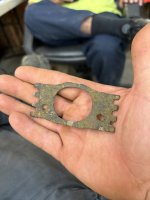fishnfacts
Full Member
- Mar 26, 2014
- 183
- 220
- Detector(s) used
- BH Disc 2200
- Primary Interest:
- All Treasure Hunting
Panning and MD'ing in Llano area. Need recommendations.
I am going to head down to Llano area for a weekend of primitive camping and looking for gold. Need recommendations on some place to camp that is close to river / creek area to pan / sluice and shale fields to detect.
I am not looking or expecting to come back a millionaire or even a hundredaire, just looking to maybe find some color and memories of a great weekend.
Thanks in advance for your help.
I am going to head down to Llano area for a weekend of primitive camping and looking for gold. Need recommendations on some place to camp that is close to river / creek area to pan / sluice and shale fields to detect.
I am not looking or expecting to come back a millionaire or even a hundredaire, just looking to maybe find some color and memories of a great weekend.
Thanks in advance for your help.




